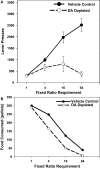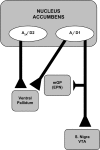Dopamine, behavioral economics, and effort
- PMID: 19826615
- PMCID: PMC2759361
- DOI: 10.3389/neuro.08.013.2009
Dopamine, behavioral economics, and effort
Abstract
There are numerous problems with the hypothesis that brain dopamine (DA) systems, particularly in the nucleus accumbens, directly mediate the rewarding or primary motivational characteristics of natural stimuli such as food. Research and theory related to the functions of mesolimbic DA are undergoing a substantial conceptual restructuring, with the traditional emphasis on hedonia and primary reward yielding to other concepts and lines of inquiry. The present review is focused upon the involvement of nucleus accumbens DA in behavioral activation and effort-related processes. Viewed from the framework of behavioral economics, the effects of accumbens DA depletions and antagonism on food-reinforced behavior are highly dependent upon the work requirements of the instrumental task, and DA depleted rats are more sensitive to increases in response costs (i.e., ratio requirements). Moreover, interference with accumbens DA transmission exerts a powerful influence over effort-related choice behavior. Rats with accumbens DA depletions or antagonism reallocate their instrumental behavior away from food-reinforced tasks that have high response requirements, and instead these rats select a less-effortful type of food-seeking behavior. Nucleus accumbens DA and adenosine interact in the regulation of effort-related functions, and other brain structures (anterior cingulate cortex, amygdala, ventral pallidum) also are involved. Studies of the brain systems regulating effort-based processes may have implications for understanding drug abuse, as well as energy-related disorders such as psychomotor slowing, fatigue or anergia in depression and other neurological disorders.
Keywords: activation; anergia; depression; motivation; nucleus accumbens; psychomotor slowing; reinforcement; reward.
Figures


References
-
- Allison J. (1981). Economics and operant conditioning. In Predictability, Correlation and Contiguity, Harzem P., Zeiler M. D., eds (New York, John Wiley and Sons; ), pp 321–353
Grants and funding
LinkOut - more resources
Full Text Sources
Other Literature Sources

